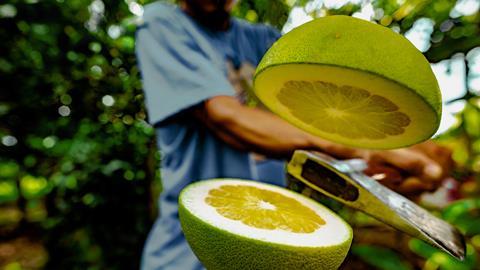Meat products are very complex due to their variety of textures and flavours. Imitating it is a challenge. In ACS Food Science & Technology, researchers from China have published the first major step towards imitating pork fat using pomelo peel.
Perfectly imitating a meat product remains a considerable challenge. This is because animal products are very complex. The structure and flavour of such a product change during preparation. Researchers from China have now examined pork fat and how to recreate it using pomelo peel. To achieve this, they used a combination of pomelo peel and pea protein. The first author, Qiaomei Zhu, explains via email: ‘We chose pomelo peel because of the large amount of waste that is associated with it.’
Besides striving for a plant-based alternative, the aim is to make it healthier too. This is because pork fat contains high levels of saturated fatty acids and cholesterol, which have negative health effects. The pomelo alternative is less likely to have these negative effects, as it still provides the texture of pork fat without being high in fat.
Previously, avocado oil and other vegetable oils have been suggested as a substitute for pork fat. However, the problem with this kind of oil is that it is liquid at room temperature. This makes it impossible to incorporate into products which require a specific texture and stability at room temperature. Therefore, Zhu and colleagues investigated High Internal Phase Pickering Emulsions (HIPPEs) as an alternative to vegetable oils.
These emulsions offer a promising alternative to conventional fat substitutes due to their phase-volume fraction of over 74%, forming polygonal droplets that provide elasticity, texture, and viscoelasticity. Thus, HIPPEs form a robust three-dimensional network that can mimic the properties of pork fat. However, HIPPEs are still relatively unstable. Adding pea protein (0.4%) and cellulose nanofibres from pomelo skin (0.7%) makes the HIPPE emulsion much more stable.
So, HIPPEs provide the necessary stability and the desired texture for the alternative fat product. There is less fat loss during frying, meaning you retain the correct texture. The aim is to add HIPPEs to more products as a healthier, plant-based alternative to pork fat. ‘We need to maximise the potential of pomelo peel waste’, concludes Zhu.
Source:
Qiaomei Zhu, ACS Food Sci. Technol. (2025), Formulation of High Internal Phase Pickering Emulsions Stabilized by Pomelo Peel-Derived Cellulose Nanofibrils and Pea Protein Isolate as Pork Fat Substitutes in Meat Patties.













Nog geen opmerkingen